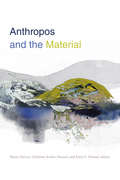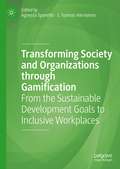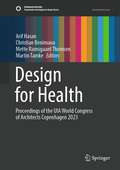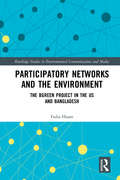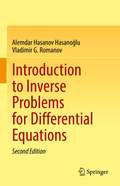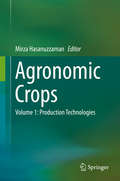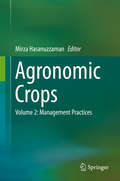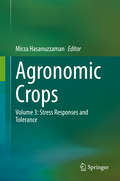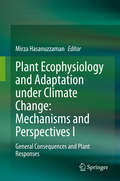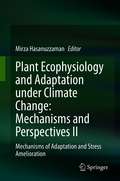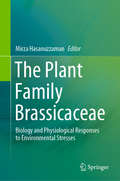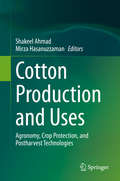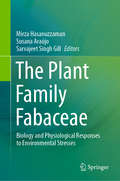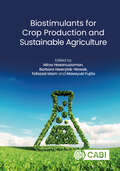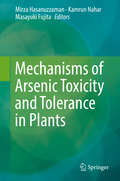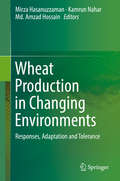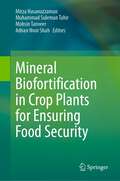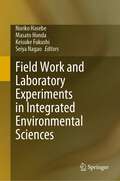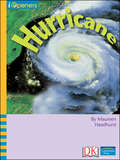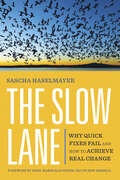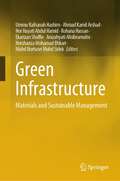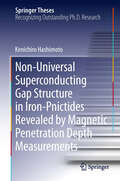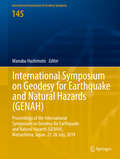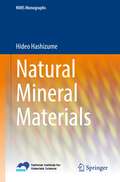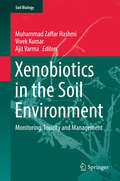- Table View
- List View
Anthropos and the Material
by Penny Harvey Christian Krohn-Hansen Knut G. NustadThe destructive effects of modern industrial societies have shaped the planet in such profound ways that many argue for the existence of a new geological epoch called the Anthropocene. This claim brings into relief a set of challenges that have deep implications for how relations between the human, the material, and the political affect contemporary social worlds. The contributors to Anthropos and the Material examine these challenges by questioning and complicating long-held understandings of the divide between humans and things. They present ethnographic case studies from across the globe, addressing myriad topics that range from labor, economics, and colonialism to technology, culture, the environment, agency, and diversity. In foregrounding the importance of connecting natural and social histories, the instability and intangibility of the material, and the ways in which the lively encounters between the human and the nonhuman challenge conceptions of liberal humanism, the contributors point to new understandings of the capacities of people and things to act, transform, and adapt to a changing world.
Transforming Society and Organizations through Gamification: From the Sustainable Development Goals to Inclusive Workplaces
by J. Tuomas Harviainen Agnessa SpanellisGamification is the application of game-design elements and game principles to non-game contexts, and has been used to solve problems by applying characteristics of games. Though it has principally been applied in the areas of business and education, this book seeks to expand focus beyond this, looking at how gamification can be used for social change, the development of organizations and the implementation of the UN Sustainable Development goals. Including contributors from across the glove, it draws on a rich array of case studies, from inclusivity in the workplace to ecosystems in the Amazon. A timely contribution to an exciting, growing field, this book engages with the theoretical framework and lays out the foundations for a rigorous theory-based stream of research. It will be valuable reading to scholars and practitioners interested in social change, sustainability, gamification and organizational studies. Agnessa Spanellis (PhD, MEng) is an Assistant Professor at Heriot-Watt University, Scotland and a member of the Research Centre for Logistics and Sustainability at Edinburgh Business School, leading research on gamification for sustainable development and exploring how gamification can improve social and environmental sustainability, especially in more deprived and impoverished communities in low-income counties. J. Tuomas Harviainen (PhD, MBA) works as Associate Professor of information Practices at Tampere University, Finland. Harviainen's work ranges from information sharing in creative organizations to games and gamification. He firmly believes that good research can also be a form of societal activism.
Design for Health: Proceedings of the UIA World Congress of Architects Copenhagen 2023 (Sustainable Development Goals Series)
by Arif Hasan Christian Benimana Mette Ramsgaard Thomsen Martin TamkeThe book provides new perspectives from leading researchers accentuating and examining the central role of the built environment in conceiving and implementing multifaceted solutions to the complex challenges of physical and mental health, revealing critical potentials for architecture and design to contribute in more informed and long-term ways to the urgent transition of our society. The volume book offers a compilation of peer-reviewed papers that uniquely connects knowledge and criticality broadly across practice and academia; from new technologies, theories, and methods to community -engaged practice on many scales, and more. The book is part of a series of six volumes that explore the agency of the built environment in relation to the SDGs through new research conducted by leading researchers. The series is led by editors Mette Ramsgaard Thomsen and Martin Tamke in collaboration with the theme editors: - Design for Climate Adaptation: Billie Faircloth and Maibritt Pedersen Zari- Design for Rethinking Resources: Carlo Ratti and Mette Ramsgaard Thomsen (Eds.)- Design for Resilient Communities: Anna Rubbo and Juan Du (Eds.)- Design for Health: Arif Hasan and Christian Benimana (Eds.)- Design for Inclusivity: Magda Mostafa and Ruth Baumeister (Eds.)- Design for Partnerships for Change: Sandi Hilal and Merve Bedir (Eds.)
Participatory Networks and the Environment: The BGreen Project in the US and Bangladesh (Routledge Studies in Environmental Communication and Media)
by Fadia HasanSeeking innovative answers to global sustainability challenges has become an urgent need with the onslaught of environmental and ecological degradation that surrounds us today. More than ever, there is a need to carve new ways for citizens and different industries and institutions to unite – to cooperate, communicate and collaborate to address growing global sustainability concerns. This book examines one such global collaboration called The BGreen Project (BGreen): a transnational participatory action research project that spans the United States and Bangladesh with the aim of addressing environmental issues via academic–community engagement. By analysing and unpacking the architecture of BGreen, Hasan teases out the key factors that are required for the continued momentum of environmentally focused, academic–community partnership projects in order to present a workable model that could be applied elsewhere. This model is based around a unique conceptual framework developed by the author – “transnational participatory networks” – which is drawn from participatory action research and actor network theory, with the specific aim of addressing the common challenge of building evolving, stable and sustainable networks. This book will be of great interest to students and scholars of environmental communication, citizen participation, environmental politics, environmental sociology and sustainable development.
Introduction to Inverse Problems for Differential Equations
by Alemdar Hasanov Hasanoğlu Vladimir G. RomanovThis book presents a systematic exposition of the main ideas and methods in treating inverse problems for PDEs arising in basic mathematical models, though it makes no claim to being exhaustive. Mathematical models of most physical phenomena are governed by initial and boundary value problems for PDEs, and inverse problems governed by these equations arise naturally in nearly all branches of science and engineering.The book’s content, especially in the Introduction and Part I, is self-contained and is intended to also be accessible for beginning graduate students, whose mathematical background includes only basic courses in advanced calculus, PDEs and functional analysis. Further, the book can be used as the backbone for a lecture course on inverse and ill-posed problems for partial differential equations.In turn, the second part of the book consists of six nearly-independent chapters. The choice of these chapters was motivated by the fact that the inverse coefficient and source problems considered here are based on the basic and commonly used mathematical models governed by PDEs. These chapters describe not only these inverse problems, but also main inversion methods and techniques. Since the most distinctive features of any inverse problems related to PDEs are hidden in the properties of the corresponding solutions to direct problems, special attention is paid to the investigation of these properties.For the second edition, the authors have added two new chapters focusing on real-world applications of inverse problems arising in wave and vibration phenomena. They have also revised the whole text of the first edition.
Agronomic Crops: Volume 1: Production Technologies
by Mirza HasanuzzamanAgronomic crops have been used to provide foods, beverages, fodders, fuels, medicines and industrial raw materials since the dawn of human civilization. Today, agronomic crops are being cultivated by employing scientific methods instead of traditional methods. However, in the current era of climate change, agronomic crops are subjected to various environmental stresses, which results in substantial yield loss. To meet the food demands of the ever-increasing global population, new technologies and management practices are being adopted to boost yield and maintain productivity under both normal and adverse conditions. Scientists are now exploring a variety of approaches to the sustainable production of agronomic crops, including varietal development, soil management, nutrient and water management, pest management, etc. Researchers have also made remarkable progress in developing stress tolerance in crops through different approaches. However, achieving optimal production to meet the increasing food demand is an open challenge. Although there have been numerous publications on the above-mentioned problems, and despite the extensive research being conducted on them, there is hardly any comprehensive book available. In response, this book offers a timely resource, addressing all aspects of production technologies, management practices and stress tolerance in agronomic crops in a single volume.
Agronomic Crops: Volume 2: Management Practices
by Mirza HasanuzzamanAgronomic crops have provided food, beverages, fodder, fuel, medicine and industrial raw materials since the beginning of human civilization. More recently, agronomic crops have been cultivated using scientific rather than traditional methods. However, in the current era of climate change, agronomic crops are suffering from different environmental stresses that result in substantial yield loss. To meet the food demands of the ever-increasing global population, new technologies and management practices are being adopted to boost yields and maintain productivity under both normal and adverse conditions. Further, in the context of sustainable agronomic crop production, scientists are adopting new approaches, such as varietal development, soil management, nutrient and water management, and pest management. Researchers have also made remarkable advances in developing stress tolerance in crops. However, the search for appropriate solutions for optimal production to meet the increasing food demand is still ongoing. Although there are several publications on the recent advances in these areas, there are few comprehensive resources available covering all of the recent topics. This timely book examines all aspects of production technologies, management practices and stress tolerance of agronomic crops.
Agronomic Crops: Volume 3: Stress Responses and Tolerance
by Mirza HasanuzzamanAgronomic crops have been a source of foods, beverages, fodders, fuels, medicines and industrial raw materials since the dawn of human civilization. Over time, these crops have come to be cultivated using scientific methods instead of traditional methods. However, in the era of climate change, agronomic crops are increasingly subjected to various environmental stresses, which results in substantial yield loss. To meet the food demands of the ever-increasing global population, new technologies and management practices are being adopted to boost yield and maintain productivity under both normal and adverse conditions. To promote the sustainable production of agronomic crops, scientists are currently exploring a range of approaches, which include varietal development, soil management, nutrient and water management, pest management etc. Researchers have also made remarkable progress in developing stress tolerance in crops through various approaches. However, finding solutions to meet the growing food demands remains a challenge. Although there are several research publications on the above-mentioned problems, there are virtually no comprehensive books addressing all of the recent topics. Accordingly, this book, which covers all aspects of production technologies, management practices, and stress tolerance of agronomic crops in a single source, offers a highly topical guide.
Plant Ecophysiology and Adaptation under Climate Change: General Consequences and Plant Responses
by Mirza HasanuzzamanThis book presents the state-of-the-art in plant ecophysiology. With a particular focus on adaptation to a changing environment, it discusses ecophysiology and adaptive mechanisms of plants under climate change. Over the centuries, the incidence of various abiotic stresses such as salinity, drought, extreme temperatures, atmospheric pollution, metal toxicity due to climate change have regularly affected plants and, and some estimates suggest that environmental stresses may reduce the crop yield by up to 70%. This in turn adversely affects the food security. As sessile organisms, plants are frequently exposed to various environmental adversities. As such, both plant physiology and plant ecophysiology begin with the study of responses to the environment. Provides essential insights, this book can be used for courses such as Plant Physiology, Environmental Science, Crop Production and Agricultural Botany.Volume 1 provides up-to-date information on the impact of climate change on plants, the general consequences and plant responses to various environmental stresses.
Plant Ecophysiology and Adaptation under Climate Change: Mechanisms of Adaptation and Stress Amelioration
by Mirza HasanuzzamanThis book presents the state-of-the-art in plant ecophysiology. With a particular focus on adaptation to a changing environment, it discusses ecophysiology and adaptive mechanisms of plants under climate change. Over the centuries, the incidence of various abiotic stresses such as salinity, drought, extreme temperatures, atmospheric pollution, metal toxicity due to climate change have regularly affected plants and, and some estimates suggest that environmental stresses may reduce the crop yield by up to 70%. This in turn adversely affects the food security. As sessile organisms, plants are frequently exposed to various environmental adversities. As such, both plant physiology and plant ecophysiology begin with the study of responses to the environment. Provides essential insights, this book can be used for courses such as Plant Physiology, Environmental Science, Crop Production and Agricultural Botany.Volume 2 provides up-to-date information on the impact of climate change on plants, the general consequences and plant responses to various environmental stresses.
The Plant Family Brassicaceae: Biology and Physiological Responses to Environmental Stresses
by Mirza HasanuzzamanThis book provides all aspects of the physiology, stress responses and tolerance to abiotic stresses of the Brassicaceae plants. Different plant families have been providing food, fodder, fuel, medicine and other basic needs for the human and animal since the ancient time. Among the plant families, Brassicaceae has special importance for their agri-horticultural importance and multifarious uses apart from the basic needs. Interest understanding the response of Brassicaceae plants toward abiotic stresses is growing considering the economic importance and the special adaptive mechanisms. The knowledge needs to be translated into improved elite lines that can contribute to achieve food security. The physiological and molecular mechanisms acting on Brassicaceae introduced in this book are useful to students and researchers working on biology, physiology, environmental interactions and biotechnology of Brassicaceae plants.
Cotton Production and Uses: Agronomy, Crop Protection, and Postharvest Technologies
by Mirza Hasanuzzaman Shakeel AhmadThis book provides a comprehensive and systematic overview of the recent developments in cotton production and processing, including a number of genetic approaches, such as GM cotton for pest resistance, which have been hotly debated in recent decades. In the era of climate change, cotton is facing diverse abiotic stresses such as salinity, drought, toxic metals and environmental pollutants. As such, scientists are developing stress-tolerant cultivars using agronomic, genetic and molecular approaches. Gathering papers on these developments, this timely book is a valuable resource for a wide audience, including plant scientists, agronomists, soil scientists, botanists, environmental scientists and extention workers.
The Plant Family Fabaceae: Biology and Physiological Responses to Environmental Stresses
by Mirza Hasanuzzaman Susana Araújo Sarvajeet Singh GillThis book comprehensively introduces all aspects of the physiology, stress responses and tolerance to abiotic stresses of the Fabaceae plants. Different plant families have been providing food, fodder, fuel, medicine and other basic needs for the human and animal since the ancient time. Among the plant families Fabaceae have special importance for their agri-horticultural importance and multifarious uses apart from the basic needs. Interest in the response of Fabaceae plants toward abiotic stresses is growing considering the economic importance and the special adaptive mechanisms. Recent advances and developments in molecular and biotechnological tools has contributed to ease and wider this mission. This book provides up-to-date findings that will be of greater use for the students and researchers, particularly Plant Physiologists, Environmental Scientists, Biotechnologists, Botanists, Food Scientists and Agronomists, to get the information on the recent advances on this plant family in regard to physiology and stress tolerance.
Biostimulants for Crop Production and Sustainable Agriculture
by Mirza Hasanuzzaman Barbara Hawrylak-Nowak Tofazzal Islam Masayuki FujitaAgricultural biostimulants are a group of substances or microorganisms, based on natural resources, that are applied to plants or soils to improve nutrient uptake and plant growth, and provide better tolerance to various stresses. Their function is to stimulate the natural processes of plants, or to enrich the soil microbiome to improve plant growth, nutrition, abiotic and/or biotic stress tolerance, yield and quality of crop plants. Interest in plant biostimulants has been on the rise over the past 10 years, driven by the growing interest of researchers and farmers in environmentally-friendly tools for improved crop performance. Focusing on recent progress on biostimulants and their role in crop production and agricultural sustainability, this book includes: 31 chapters on a wide range of biostimulants and their role in plant growth stimulation and stress tolerance. Mechanism of actions of diverse groups of biostimulants, such as trace elements, plant and seaweed extracts, humic substances, polyamines, osmolytes, vitamins, nanoparticles and microorganisms. New promising biostimulants with novel modes of action. Improved crop production technologies are urgently needed to meet the growing demand for food for the ever-increasing global population by addressing the impacts of changing climate on agriculture. This book is of interest to researchers in agriculture, agronomy, crop and plant science, soil science and environmental science.
Mechanisms of Arsenic Toxicity and Tolerance in Plants
by Mirza Hasanuzzaman Kamrun Nahar Masayuki FujitaArsenic is likely the most talked-about metalloid in the modern world because of its toxic effects on both animal and plants. Further, arsenic pollution is now producing negative impacts on food security, especially in many south Asian countries. Since plants are a major food source, their adaptation to As-rich environments is essential, as is being informed about recent findings on multifarious aspects of the mechanisms of arsenic toxicity and tolerance in plants. Although numerous research works and review articles have been published in journals, annual reviews and as book chapters, to date there has been no comprehensive book on this topic.This book contains 19 informative chapters on arsenic chemistry, plant uptake, toxicity and tolerance mechanisms, as well as approaches to mitigation. Readers will be introduced to the latest findings on plant responses to arsenic toxicity, various tolerance mechanisms, and remediation techniques. As such, the book offers a timely and valuable resource for a broad audience, including plant scientists, soil scientists, environmental scientists, agronomists, botanists and molecular biologists.
Wheat Production in Changing Environments: Responses, Adaptation and Tolerance
by Mirza Hasanuzzaman Kamrun Nahar Md. Amzad HossainThis book presents recent advances in global wheat crop research, including the effects of abiotic stresses like high and low temperatures, drought, hypoxia, salinity, heavy metals, nutrient deficiency, and toxicity on wheat production. It also highlights various approaches to alleviate the damaging effects of abiotic stress on wheat as well as advanced approaches to develop abiotic-stress-tolerant wheat crops. Wheat is probably one of the world’s most important cereals; it is a staple food in more than 40 countries, and because of its adaptability is cultivated in almost every region. Global wheat production has more than doubled in the last 50 years due to higher yields. However, despite their high yield potential, modern wheat cultivars are often subject to crop loss due to the abiotic stresses. As such, plant breeders have long aimed to improve tolerance in order to maintain yield. Written by 85 experts, and offering the latest insights into wheat responses and tolerance to various abiotic stresses, it is a valuable tool for agronomists, plant breeders, plant physiologists and students in the field of plant science and agriculture. It is the first book to comprehensively cover past and current abiotic stress problems and tolerance mechanisms.
Mineral Biofortification in Crop Plants for Ensuring Food Security
by Mirza Hasanuzzaman Muhammad Suleman Tahir Mohsin Tanveer Adnan Noor ShahThis book provides a comprehensive summary of the recent advances in the biofortification of plants under climate change and how it affects food security globally. The need for mineral biofortification to eradicate or alleviate malnutrition through sustainable agriculture is also discussed. Biofortification of edible plants is considered the most appropriate approach to alleviate nutritional problems and nutrient deficiencies. In contrast, biofortification focuses on improving the nutritional content of the region's current agricultural biodiversity while preserving its habits and customs. Emphasis is also placed on recent advances and developments in omics, particularly metabolomics and related techniques, to unravel the potential alterations in plants caused by biofortification. The book brings together eminent scientists to present the latest developments in the field. This timely publication addresses practical scenarios of bio-fortified food production and climate change. The book focuses on the methods, techniques, and environmental changes used to enhance and improve agricultural products. This book is one of the first to provide information on the use of modern biotechnologies to modify crops for health benefits. It also examines the mechanisms of the plant responses to genetically induced biofortification, the production and responses of fortified plants under climate change, and their effects on food security. The book will be useful for students and researchers, especially crop scientists, environmental scientists, biotechnologists, botanists, and agronomists, to understand the techniques and mechanisms of biofortification, and responses of biofortified plants under climate change.
Field Work and Laboratory Experiments in Integrated Environmental Sciences
by Noriko Hasebe Masato Honda Keisuke Fukushi Seiya NagaoThis book introduces the variety of research skills necessary for integrated environmental science, which are applicable to atmospheric, oceanic, terrestrial, and biota studies. The surface environment of the earth is a complex system consisting of atmospheric, oceanic, and terrestrial regions as well as the biota therein, all of which interact with one another to various extents. The integration of research disciplines including earth science, biology, chemistry, physics, and social science is a core of environmental science. It encourages students and early-career scientists to take a broad view of the whole environmental system. Detailed practical information for the field or laboratory work in this book helps students and scientists to plan research strategy for their own scope and interests. In addition, this book is also useful for professionals to teach field and laboratory work in environmental science to students. This book is based on the environmental summer school program organized by the Institute of Nature and Environmental Technology, Kanazawa University, in Japan.
iOpener: Hurricane (iOpeners)
by Maureen HaselhustThis book covers everything you need to know about this natural disaster, from how hurricanes develop to how to prepare for one. Diagrams, maps, and photographs bring the subject to life, while a glossary, an index, and discussion questions aid in reading comprehension.Grade: 4Subject: Earth ScienceGenre: Nonfiction NarrativeComprehension Skill/Strategy: Draw ConclusionsDiagnostic Reading Assessment (DRA/EDL): 40Guided Reading Level: RLexile Level: 780LDK's iOpeners equip K-6 students with the skills and strategies they need to access and comprehend nonfiction so that they are not only learning to read but reading to learn. The combination of high-interest content and eye-popping photography of iOpeners brings science and social studies topics to life, raises student achievement in reading, and boosts standardized test scores.
The Slow Lane: Why Quick Fixes Fail and How to Achieve Real Change
by Sascha HaselmayerAvoid the speed trap! Discover how changemakers can find lasting solutions to urgent social problems through a proven 5-step process for listening thoughtfully, building broad support, and exploring unconventional options.Society celebrates leaders who promise fast, easy solutions to the world's problems-but quick fixes are just mirages that fade, leaving us with the same broken systems. The truth is, effective social change happens through slow, intentional actions. The author, a globally acclaimed social entrepreneur, offers a 5-step process for taking the slow lane to change-the lane that gets you to the right place faster: Listening-Listen to build trust, which can change hearts and minds and allow for something new to emerge. Holding the urgency-Accept that even in moments of crisis you can move only at the speed of trust instead of rushing into action. Sharing the agency-Create an inclusive environment where everyone can lead. Healing democracy-Build bridges that allow marginalized people to participate. Maintaining curiosity-Be inspired by nontraditional sources.Using dozens of examples-prison reform in England, urban development in Venezuela, healthcare in the Navajo Nation, early childhood education in New York, and many more- The Slow Lane shows how, by following the principles taught in this book, readers can create lasting change.
Green Infrastructure: Materials and Sustainable Management
by Ummu Raihanah Hashim Ahmad Kamil Arshad Nor Hayati Abdul Hamid Rohana Hassan Ekarizan Shaffie Anizahyati Alisibramulisi Norshariza Mohamad Bhkari Muhd Norhasri Muhd SidekThis second volume of "Green Infrastructure" provides a comprehensive exploration of both established and evolving green infrastructure materials, along with sustainable practices across various facets that hold the potential to shape our future. Emphasizing emerging domain materials such as timber, concrete, soil, and pavement, among others, this book delves into the pivotal role these elements play in fostering sustainable urban development. It underscores the significance of these materials in preserving ecosystem services and constructive management, thus leading to the attainment of manifold advantages. Bridging a critical void in the existing literature, this volume serves as an indispensable resource, serving to guide forthcoming research endeavors concerning green materials and their applications within the realm of sustainability.
Non-Universal Superconducting Gap Structure in Iron-Pnictides Revealed by Magnetic Penetration Depth Measurements
by Kenichiro HashimotoIn this book the author presents two important findings revealed by high-precision magnetic penetration depth measurements in iron-based superconductors which exhibit high-transition temperature superconductivity up to 55 K: one is the fact that the superconducting gap structure in iron-based superconductors depends on a detailed electronic structure of individual materials, and the other is the first strong evidence for the presence of a quantum critical point (QCP) beneath the superconducting dome of iron-based superconductors. The magnetic penetration depth is a powerful probe to elucidate the superconducting gap structure which is intimately related to the pairing mechanism of superconductivity. The author discusses the possible gap structure of individual iron-based superconductors by comparing the gap structure obtained from the penetration depth measurements with theoretical predictions, indicating that the non-universal superconducting gap structure in iron-pnictides can be interpreted in the framework of A1g symmetry. This result imposes a strong constraint on the pairing mechanism of iron-based superconductors. The author also shows clear evidence for the quantum criticality inside the superconducting dome from the absolute zero-temperature penetration depth measurements as a function of chemical composition. A sharp peak of the penetration depth at a certain composition demonstrates pronounced quantum fluctuations associated with the QCP, which separates two distinct superconducting phases. This gives the first convincing signature of a second-order quantum phase transition deep inside the superconducting dome, which may address a key question on the general phase diagram of unconventional superconductivity in the vicinity of a QCP.
International Symposium on Geodesy for Earthquake and Natural Hazards (GENAH)
by Manabu HashimotoThese proceedings contain a selection of peer-reviewed papers presented at the International Symposium on Geodesy for Earthquake and Natural Hazards (GENAH), Matsushima, Japan, 22-26 July, 2014. The scientific sessions focused on monitoring temporal and spatial changes in Earth's lithosphere and atmosphere using geodetic satellite systems, high rate GNSS as well as high resolution imaging (InSAR, Lidar). Researchers in various fields of geodesy discussed the role of geodesy in disaster mitigation and how groups with different techniques can collaborate toward such a goal.
Natural Mineral Materials (NIMS Monographs)
by Hideo HashizumeThis book presents natural minerals used as inorganic materials, and inorganic materials exchanging cations or anions in natural minerals for other ions not found in nature. In addition, composites such as natural mineral materials that interact with organic molecules or polymers are introduced according to how they are used.Readers can refer to this volume as a guidebook to search for specific inorganic materials, and, if they wish, can consult any part of it at random. The book will be especially helpful and of interest to both scientists and engineers.
Xenobiotics in the Soil Environment
by Muhammad Zaffar Hashmi Vivek Kumar Ajit VarmaThis book describes the vast variety of xenobiotics, such as pesticides, antibiotics, antibiotic resistance genes, agrochemicals and other pollutants, their interactions with the soil environment, and the currently available strategies and techniques for soil decontamination and bioremediation. Topics covered include: transport mechanisms of pollutants along the Himalayas; use of earthworms in biomonitoring; metagenomic strategies for assessing contaminated sites; xenobiotics in the food chain; phyto-chemical remediation; biodegradation by fungi; and the use of enzymes and potential microbes in biotransformation. Accordingly, the book offers a valuable guide for scientists in the fields of environmental ecology, soil and food sciences, agriculture, and applied microbiology.
